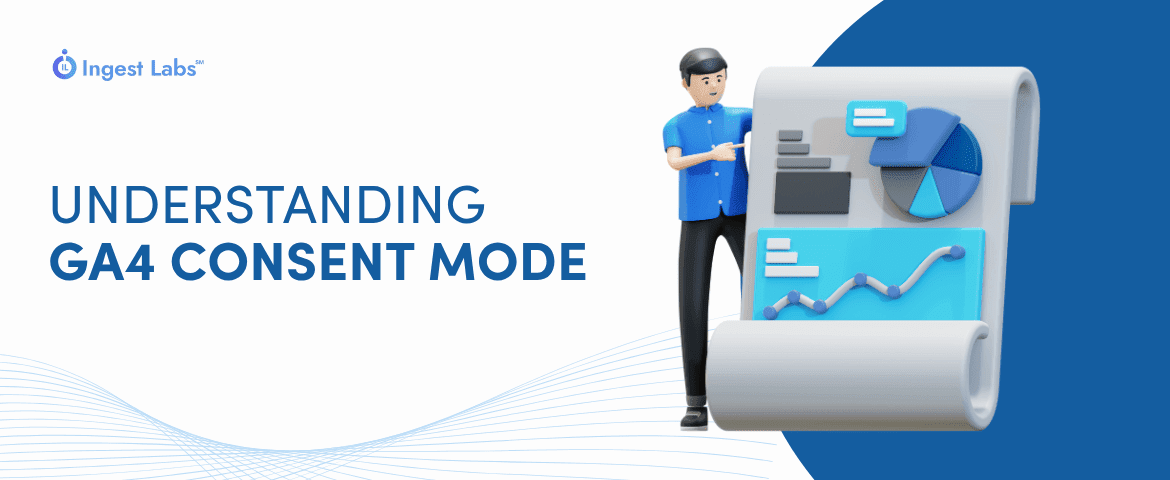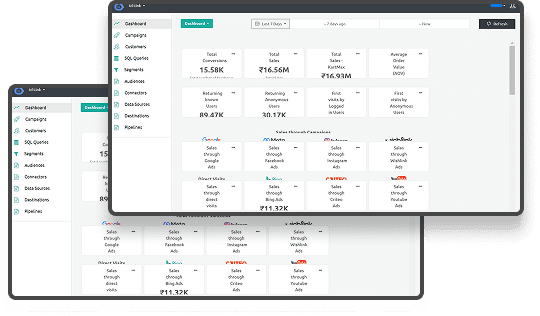Understanding GA4 Consent Mode: Setup and Impact
How can you maintain accurate marketing insights when growing privacy regulations limit the collection of user data?
Increasing restrictions on tracking and consent have created significant gaps in conversion data, making it more challenging to understand customer journeys and optimize campaigns fully. Google’s Consent Mode for GA4 addresses this challenge by adjusting data collection based on user consent, allowing businesses to recover valuable insights while respecting privacy requirements.
For instance, after implementing Consent Mode, Air France saw a 9% rise in visible conversions across Europe, overcoming the impact of lower cookie acceptance rates. Furthermore, Google’s AI-powered modeling recovers about 65% of conversions lost due to consent denial, helping ensure more reliable campaign performance measurement.
As privacy becomes a central concern, mastering Consent Mode GA4 setup is vital for maintaining effective data-driven strategies without sacrificing compliance. This guide covers everything you need to know to implement and benefit from Consent Mode GA4.
What is GA4 Consent Mode?
Google Analytics 4’s Consent Mode allows businesses to tailor their data collection practices to user consent. By using Consent Mode, marketers can respect privacy regulations by collecting data only when users consent. In doing so, GA4 helps businesses comply with critical data privacy laws like GDPR and CCPA without losing valuable data insights.
Key Features of GA4 Consent Mode:
- Consent-based Tracking: GA4 allows for granular control over consent for both analytics and advertising features.
- Real-Time Data Collection: Even with limited consent, GA4 can still collect basic, anonymous data without compromising privacy.
- Compatibility with Other Google Services: Consent Mode works across Google Ads, Google Tag Manager, and other Google products, ensuring a consistent data strategy.
Now that you understand what Consent Mode does, it's time to see why aligning your data strategy with it can benefit your business long term.
Why is GA4 Consent Mode Important for Your Business?
As privacy laws tighten and users become more conscious of how their data is used, GA4 Consent Mode plays a crucial role in maintaining trust while gathering insightful data. Here’s why it matters:
1. Compliance with Privacy Laws
Maintaining adherence to changing privacy regulations is essential for companies. Here’s why it’s important:
- GDPR, CCPA, ePrivacy: Businesses must ensure compliance with stricter data protection laws worldwide. Consent Mode aligns with these regulations by respecting user choices on whether to consent to tracking.
- Avoid Penalties: Non-compliance can lead to severe penalties. Using GA4 Consent Mode, you mitigate legal risks associated with data privacy violations, while tools from Ingest Labs help manage consent signals and ensure compliant data flows.
2. Optimized Data Collection
Optimizing how data is collected can improve user insights while respecting privacy preferences. Here’s how it works:
- Enhanced User Insights: Even when users decline consent for personalized ads, GA4 collects anonymized data, allowing businesses to make data-driven decisions with the available information.
- Customizable Data Preferences: Users can select what type of data they want to share, allowing businesses to collect only what is permitted.
3. Building Trust with Users
Trust serves as a fundamental element within any business relationship. The following points elucidate its significance:
- Transparent Data Practices: Users appreciate transparency in how their data is used. By integrating Consent Mode, you commit to privacy and building long-term trust.
- Improved User Experience: Respecting user preferences can lead to a more positive experience, ultimately enhancing customer loyalty.
Understanding the value is one thing, but knowing how it operates on a technical level is what truly unlocks its potential. Here's how it functions behind the scenes.
Read: Optimizing eCommerce with Ingest Labs: From Cart Abandonment to Conversion.
How Does GA4 Consent Mode Work?
GA4 Consent Mode operates on a dynamic framework where the tracking behaviors change based on the user’s consent. It works by adjusting the behavior of Google tags based on the user's choices. These choices are communicated to Google via custom code and the gtag function.
- Consent Categories:
- Analytics Consent: This category allows businesses to track user interactions and gather data for analysis.
- Ads Consent: This consent focuses on personalized advertising, allowing businesses to target users with relevant ads.
- Consent Modes in Action:
- Full Consent: If users consent to analytics and ads, full tracking is enabled, and Google services can collect detailed data.
- Partial Consent: If users consent only to analytics or ads, Google tags will adjust to limit data collection by their preferences.
- No Consent: If a user opts out of both, no data is collected, ensuring compliance.
Understanding how Consent Mode responds to user preferences lays the groundwork for implementing it effectively. The following section walks you through each step of the setup process.
Step-by-Step Guide to Setting Up GA4 Consent Mode
Setting up GA4 Consent Mode can seem technical, but following these steps ensures smooth integration. Here’s how to implement it:
Step 1: Set Up Google Tag Manager (GTM)
- Install Google Tag Manager: Ensure that Google Tag Manager (GTM) is installed on your website. Follow the Google Tag Manager installation guide if it's not set up.
- Create a Container: After installing the GTM, create a container for your website. This is where all your tracking tags will be managed.
Step 2: Add the Consent Initialization Tag
- Create a New Tag for Consent Initialization: In GTM, create a new tag dedicated to initializing the Consent Mode when the page loads.
- Tag Type: Use the Consent Initialization tag type in GTM.
- Trigger: Set the trigger to Page Load to initialize consent as soon as the page opens.
- Modify Tags for GA4: Once consent is initialized, modify your GA4 tags to respect the user's consent choices. To do this, select the Enable Consent Mode checkbox in the Tag Settings for each GA4 tag.
Step 3: Customize User Consent Prompt
- Design Consent Banner: Use a cookie consent tool (like Cookiebot or OneTrust) to create a user-friendly consent banner that clearly outlines what data will be collected and for what purpose.
- Offer Granular Choices: Users can consent to specific tracking types, such as analytics or personalized ads.
- Example:
- “Do you consent to personalized ads?”
- “Do you consent to tracking for analytics?”
- Example:
Step 4: Implement Consent Logic in Code
Once you have your consent prompt, implement the JavaScript code to pass consent preferences to GA4. This is typically done using the gtag() function:
gtag('consent', 'update', {
'ad_storage': 'granted', // For personalized ads
'analytics_storage': 'granted' // For analytics tracking
});
This code should dynamically change based on the user’s consent choices.
Step 5: Testing and Verification
- Test Your Tags: Use tools like Google Tag Assistant or the GA4 DebugView to ensure the tags function as expected and comply with the user's consent choices.
- Monitor Consent Responses: Ensure that users who decline consent are not tracked for analytics or advertising purposes.
With setup complete, it’s essential to evaluate the impact of Consent Mode on the quality and completeness of your data.
Impact of GA4 Consent Mode on Data Collection
GA4 Consent Mode provides businesses with a compliant way to manage user data collection, but it inevitably comes with trade-offs.
1. Data Availability
Data availability can be significantly affected depending on whether the user provides consent or not. Here are the implications:
- Without Consent: Some data may not be available if the user opts out. This includes demographic data, site behavior, or detailed conversion tracking.
- With Consent: Data collection continues normally, providing valuable insights into user behavior, conversions, and marketing campaign effectiveness.
2. Data Quality
The quality of the data collected can vary depending on the consent levels. Here’s how it is impacted:
- Limited Data: In scenarios where users opt out, only a portion of your audience will be tracked. You can still gather anonymous data, but it will be less detailed.
- Granular Reporting: With full consent, GA4 can provide comprehensive reporting, allowing businesses to analyze the effectiveness of their campaigns in depth.
3. Reporting and Analytics
Reporting accuracy and insights may be compromised if users don’t provide consent. Below are the key effects:
- Impact on Data Accuracy: Consent Mode only collects data with explicit consent, which may result in a decrease in the overall data volume, potentially affecting trend analysis and reporting.
- Accuracy in Conversion Tracking: Without consent for personalized ads, businesses will have less visibility into individual conversions and user behavior across sessions.
Ingest Labs addresses gaps with products like Ingest IQ and Event IQ, enabling server-side tracking and unified behavioral data in low-consent environments.
Supporting anonymized tracking and privacy-compliant data orchestration through Ingest ID helps businesses maintain insights while respecting user preferences.
Gaps in data don't have to mean gaps in insight. The next section covers key practices that help preserve trust and measurement quality over time.
Read: The Privacy Revolution in Marketing: A Guide to Navigating the New Landscape
Best Practices for Implementing GA4 Consent Mode
To fully leverage GA4 Consent Mode, it’s essential to go beyond implementation and embrace a strategy grounded in transparency, user trust, and data integrity. These best practices improve compliance and drive more accurate measurement and long-term marketing performance.
- Be Transparent About Data Usage
Transparency is foundational to any privacy-first strategy. Make it clear to users what data types are being collected, how that data will be used, and who it might be shared with. Transparent and honest disclosures help establish credibility and build user trust. Ingest Labs' Event IQ enhances transparency with unified data views and AI-powered insights, allowing marketers to communicate data use more clearly and effectively.
- Offer Detailed Consent Options
Users can control their consent preferences by opting separately for analytics, advertising, and personalization. This enhances autonomy and improves data quality, aiding ethical compliance. Ingest Labs’ Privacy Compliance via Event IQ ensures adherence to GDPR, CCPA, and other laws while facilitating easy preference management.
- Test Across Platforms
Testing consent flows across devices, browsers, and platforms ensures a consistent user experience. Discrepancies can cause data gaps or compliance risks, making validation under real-world conditions critical. This step is essential for maintaining trust and reliable data collection. Ingest IQ's server-side tracking enables accurate data capture even in restrictive browser environments, preserving consent integrity.
- Use Privacy-Centric Tools
Implementing privacy tools like Cookiebot or OneTrust automates consent collection and ensures compliance with global regulations. These tools reduce the technical complexity of integrating with GA4 Consent Mode, minimizing errors while protecting user rights. Ingest Labs’ Event IQ enhances this by managing consent frameworks and tracking real-time user behavior for deeper, ethical personalization.
Ingest Labs offers tailored solutions with Ingest ID, Ingest IQ, and Event IQ to ensure compliance with GA4 Consent Mode and provide deeper customer insights. Whether streamlining server-side tracking, centralizing customer data, or improving attribution, Ingest Labs provides privacy-first tools for growth and accountability.
Final Thoughts
GA4 Consent Mode requires consent-aware practices to change how businesses collect and analyze user data. However, relying only on browser-based tracking can lead to gaps in measurement and incomplete insights when users decline consent. This affects the accuracy of reporting, attribution, and campaign performance metrics. To maintain data continuity and compliance, businesses need infrastructure supporting anonymized tracking, server-side data collection, and centralized consent handling.
Ingest Labs supports this approach with Ingest IQ, Event IQ, and Ingest ID, solutions designed to extend GA4 Consent Mode with reliable, privacy-compliant tracking. These tools help consolidate user behavior data, ensure consent-based data flows, and retain visibility into performance across all user journeys.Schedule a demo with Ingest Labs today to strengthen your consent strategy and improve data quality.






